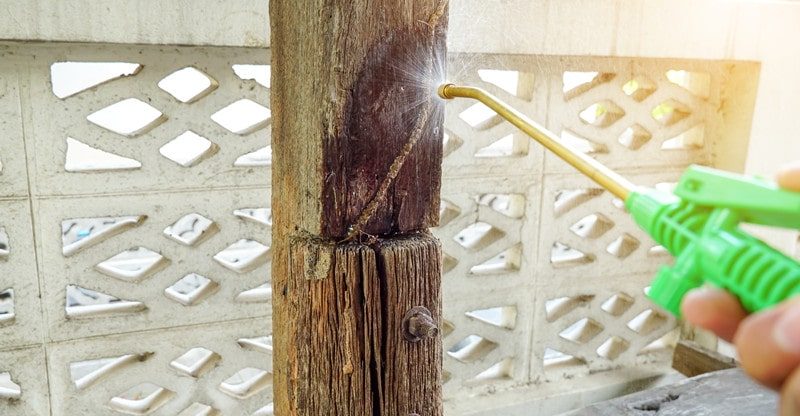Choosing the Right Termite Treatment in Alexandria, VA
To prevent termites from causing extensive damage, you should stay vigilant looking for signs of an infestation. If you do find termites, it’s key to begin a treatment plan immediately. Homeowners have many options to choose from when treating termites, including:
- Soil and barrier treatments
- Bait stations
- Wood treatments
- Fumigation
To decide on the best treatment plan for your home in Alexandria, it is best to consult a pest control expert, such as Connor’s Pest Pros in Alexandria, VA. They can assess the extent of your termite issue and recommend the most effective course of action. Read on to learn more about which termite treatments could be beneficial for your property!
Option 1: Soil & Barrier Treatments
Soil and barrier termite treatments involve digging a trench around your home and treating the soil with termiticide to protect your home from termites. Any returning termites will be killed and future infestations will be prevented.
Soil and barrier treatments are effective at protecting both the inside and outside of your home and are less invasive and relatively inexpensive. The treatment lasts for up to 5 years and provides fast results.
Soil and barrier treatment is only effective on subterranean termites, and become ineffective if the soil under the barrier gets wet because gaps might occur allowing termites to get into your home.
Option 2: Termite Bait Stations
If you are facing a termite infestation, another effective solution is using termite bait stations. This is the process of this method:
- Bait stations are strategically placed around your home
- They are regularly checked and replenished as needed.
- The bait attracts termites, which then bring it back to the colony and ultimately destroys it.
There are several advantages to using bait stations for termite control. They come in above-ground and below-ground varieties to suit various infestation types. Unlike chemical treatments, bait stations are environmentally friendly. They provide long-term protection and eliminate termite colonies at their source without the need for extensive drilling or digging. Additionally, the decreased use of termiticide means fewer health risks.
As with any termite treatment method, there are some limitations to consider with bait stations:
- They can be more costly than soil barrier treatments
- They require specialized training and consistent monitoring to be effective
- Results may take time and are not immediately visible
Overall, bait termite treatments can be a viable option for long-term termite control and eradication, provided you are aware of their pros and cons and take the necessary steps to ensure their effectiveness.
Option 3: Wood Treatments
Another, more invasive option to help prevent a termite infestation is using termite-resistant or pressure-treated wood when building. Using termite-resistant wood and wood sealants is less expensive than some other treatment options, and can help prevent termites because:
- Several termite-resistant wood options exist, such as cedar, teak, redwood, and pressure-treated wood.
- Wood sealant can be applied to existing wood, preventing moisture and rotting that attract termites.
Keep in mind that treated wood may not be effective in treating an active invasion and require reapplication due to exposure to weather conditions and moisture. It may be difficult to find and treat every wooden surface that termites may be attracted to.
Option 3: Fumigation
Fumigation entails sealing off the affected area and using sulfuryl fluoride gas, also known as Vikane, to eradicate the entire termite colony. The process can take up to three days. Fumigation is the best option for severe and widespread termite infestations. The treatment is effective, and you can enjoy the following benefits:
- Peace of mind knowing that the termite colony is eradicated
- Vikane gas doesn’t leave any residue and naturally disperses so your home is safe for re-entry
Although fumigation is an effective solution for severe termite infestations, it has a few drawbacks to consider:
- Fumigation is invasive and costly, and requires you, your family, and pets to leave your home for at least three days
- This treatment only targets the current infestation, and there’s no guarantee that a future termite colony won’t form
- The effectiveness of the treatment varies based on the termite species. It’s not effective against the common subterranean termite and their underground nests.
There are many different types of termite treatment, and ech home and infestation requires different methods. If you are unsure about which treatment might be best for your circumstances, be sure to reach out to a professional exterminator in your area!



